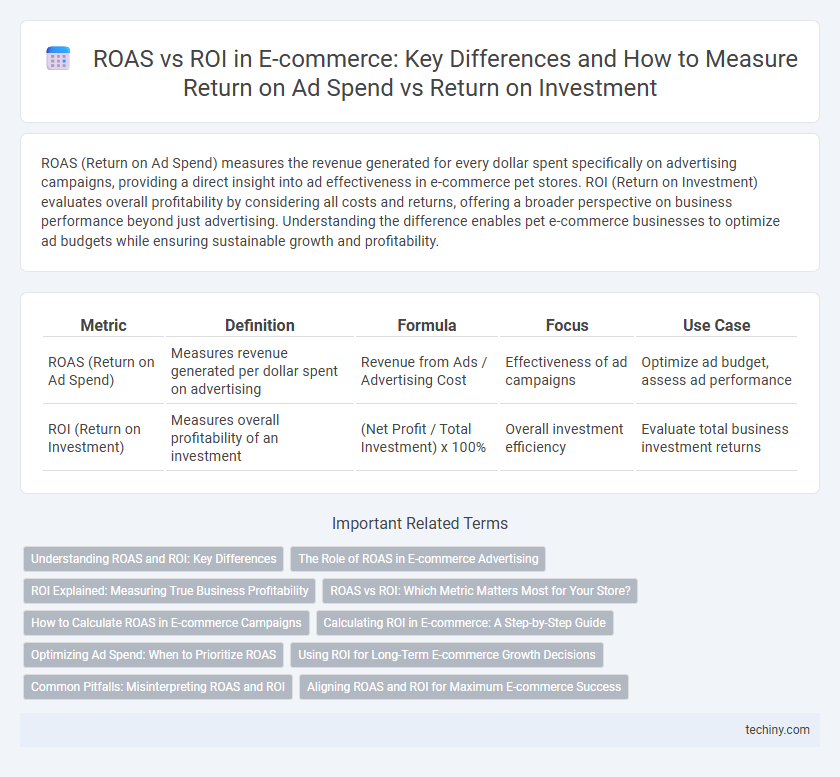ROAS (Return on Ad Spend) measures the revenue generated for every dollar spent specifically on advertising campaigns, providing a direct insight into ad effectiveness in e-commerce pet stores. ROI (Return on Investment) evaluates overall profitability by considering all costs and returns, offering a broader perspective on business performance beyond just advertising. Understanding the difference enables pet e-commerce businesses to optimize ad budgets while ensuring sustainable growth and profitability.
Table of Comparison
| Metric | Definition | Formula | Focus | Use Case |
|---|---|---|---|---|
| ROAS (Return on Ad Spend) | Measures revenue generated per dollar spent on advertising | Revenue from Ads / Advertising Cost | Effectiveness of ad campaigns | Optimize ad budget, assess ad performance |
| ROI (Return on Investment) | Measures overall profitability of an investment | (Net Profit / Total Investment) x 100% | Overall investment efficiency | Evaluate total business investment returns |
Understanding ROAS and ROI: Key Differences
ROAS (Return on Ad Spend) measures the revenue generated for every dollar spent specifically on advertising campaigns, providing immediate insight into ad performance and efficiency. ROI (Return on Investment) evaluates the overall profitability of an investment by comparing net profit to total costs, encompassing all business expenses beyond advertising. Understanding these key differences helps e-commerce businesses optimize marketing budgets and strategic decision-making to maximize both short-term ad effectiveness and long-term financial returns.
The Role of ROAS in E-commerce Advertising
ROAS (Return on Ad Spend) is a critical metric in e-commerce advertising, measuring the revenue generated for every dollar spent on ads, directly reflecting campaign effectiveness. Unlike ROI, which takes all investment costs into account, ROAS provides precise insights into ad spend efficiency, helping marketers optimize budget allocation across channels. By analyzing ROAS, e-commerce businesses can identify high-performing campaigns, improve targeting strategies, and maximize revenue growth from paid advertising efforts.
ROI Explained: Measuring True Business Profitability
ROI (Return on Investment) provides a comprehensive measure of true business profitability by calculating the net profit relative to the total investment, encompassing all expenses beyond ad spend such as operational costs, product sourcing, and overheads. Unlike ROAS (Return on Ad Spend), which focuses solely on revenue generated per advertising dollar, ROI evaluates the overall financial health and sustainability of e-commerce initiatives. This holistic approach ensures that businesses can make more informed decisions by understanding the actual return after factoring in all associated costs.
ROAS vs ROI: Which Metric Matters Most for Your Store?
ROAS measures the immediate revenue generated from advertising spend, providing a clear picture of ad campaign efficiency, while ROI accounts for overall profitability by including all costs and long-term returns. For e-commerce stores focused on scaling paid ads and optimizing marketing budgets, ROAS offers actionable insights to increase sales directly linked to advertising efforts. However, evaluating ROI ensures comprehensive business health by factoring in operational expenses, helping stores make strategic decisions beyond just ad performance.
How to Calculate ROAS in E-commerce Campaigns
ROAS in e-commerce campaigns is calculated by dividing the total revenue generated from ads by the total ad spend, expressed as a ratio or percentage. For example, if $10,000 in sales results from a $2,000 ad spend, the ROAS is 5:1 or 500%. This metric helps marketers assess the effectiveness of advertising spend by directly measuring return from specific campaigns without considering broader business expenses.
Calculating ROI in E-commerce: A Step-by-Step Guide
Calculating ROI in e-commerce involves subtracting the total investment cost from the net profit, then dividing the result by the total investment cost to express it as a percentage. This metric provides a comprehensive view of overall profitability beyond ad spend, incorporating costs like product sourcing, shipping, and platform fees. Tracking ROI alongside ROAS enables e-commerce businesses to optimize marketing strategies while ensuring sustainable growth and operational efficiency.
Optimizing Ad Spend: When to Prioritize ROAS
Optimizing ad spend in e-commerce requires prioritizing ROAS when campaigns target specific sales-driven goals, as ROAS measures the immediate revenue generated for every dollar spent on advertising. Unlike ROI, which considers overall profitability by factoring in total investment costs including operational expenses, ROAS focuses solely on advertising efficiency, making it crucial for real-time budgeting and campaign adjustments. Prioritizing ROAS is essential when maximizing direct ad revenue and scaling successful ad sets rapidly within platforms like Google Ads and Facebook Ads.
Using ROI for Long-Term E-commerce Growth Decisions
ROI measures the overall profitability of e-commerce investments by comparing net profit to total costs, offering a comprehensive view of long-term business viability beyond immediate ad performance. ROAS focuses solely on revenue generated per advertising dollar, providing quick insights into campaign efficiency but lacking broader financial context. Using ROI enables e-commerce businesses to make strategic growth decisions that account for all expenses, customer lifetime value, and operational scalability, fostering sustainable expansion.
Common Pitfalls: Misinterpreting ROAS and ROI
Misinterpreting ROAS and ROI in e-commerce leads to flawed marketing strategies as ROAS measures immediate revenue generated per ad dollar while ROI accounts for overall profitability, including costs beyond advertising. Ignoring operational expenses or customer lifetime value results in overestimating campaign success when focusing solely on ROAS. Precise differentiation between ROAS and ROI is crucial to optimize ad budgets and achieve sustainable business growth.
Aligning ROAS and ROI for Maximum E-commerce Success
Aligning ROAS and ROI in e-commerce drives precise evaluation of paid advertising performance and overall profitability, ensuring ad spend directly contributes to net gains. Emphasizing ROAS measures the immediate revenue generated per advertising dollar, while integrating ROI accounts for total costs including overhead and operational expenses. Optimizing strategies that balance high ROAS with positive ROI maximizes sustainable growth and long-term return on every advertising investment.
ROAS (Return on Ad Spend) vs ROI (Return on Investment) Infographic

 techiny.com
techiny.com